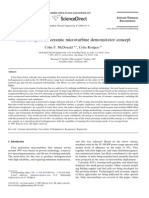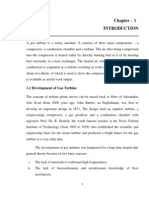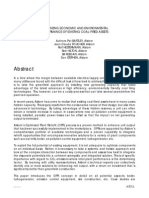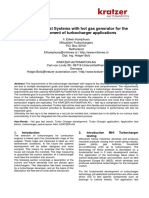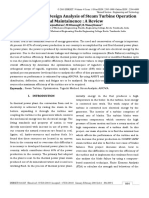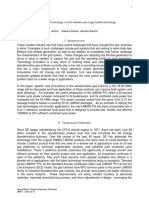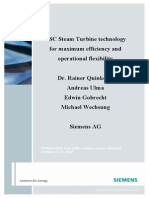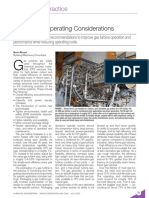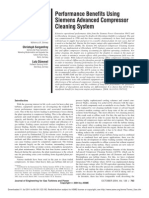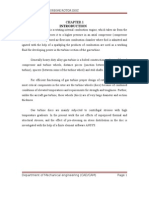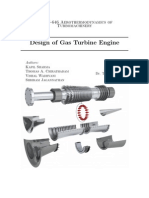Performance Study of A 1 MW Gas Turbine: Paper CIT04-0089
Performance Study of A 1 MW Gas Turbine: Paper CIT04-0089
Uploaded by
Abbas MohajerCopyright:
Available Formats
Performance Study of A 1 MW Gas Turbine: Paper CIT04-0089
Performance Study of A 1 MW Gas Turbine: Paper CIT04-0089
Uploaded by
Abbas MohajerOriginal Description:
Original Title
Copyright
Available Formats
Share this document
Did you find this document useful?
Is this content inappropriate?
Copyright:
Available Formats
Performance Study of A 1 MW Gas Turbine: Paper CIT04-0089
Performance Study of A 1 MW Gas Turbine: Paper CIT04-0089
Uploaded by
Abbas MohajerCopyright:
Available Formats
Proceedings of the 10th Brazilian Congress of Thermal Sciences and Engineering -- ENCIT 2004
Braz. Soc. of Mechanical Sciences and Engineering -- ABCM, Rio de Janeiro, Brazil, Nov. 29 -- Dec. 03, 2004
Paper CIT04-0089
PERFORMANCE STUDY OF A 1 MW GAS TURBINE
Cleverson Bringhenti
Instituto Tecnolgico de Aeronutica
CTA-ITA-IEM, Gas Turbine Group
So J os dos Campos, SP - Brazil, 12228-900
cleverso@mec.ita.br
Joo Roberto Barbosa
Instituto Tecnolgico de Aeronutica
CTA-ITA-IEM, Gas Turbine Group
So J os dos Campos, SP - Brazil, 12228-900
barbosa@mec.ita.br
Abstract. The conception of a gas turbine of 1MW power generation is the aim of this work. Design parameters are obtained from
cycle calculations based on target component performances appropriate for such an engine. Using compressor and turbine maps
specially designed for the engine, the gas turbine overall performance is studied. Part-load performance is studied aiming at
operation away from design at acceptable efficiency levels. Results from engine performance calculations are fed back to the
compressor and turbine studies, in order to incorporate the engine overall performance needs.
Keywords. gas turbine, performance, power generation, turbine.
1. Introduction
In this work attention is focused on industrial gas turbines for power generation. Distinction between aircraft gas
turbine and industrial gas turbine has to be made for three main reasons: Firstly, the life required of an industrial
plant without overhaul is much larger than that for aeronautical power plant. Secondly, limitation of the size and weight
of an aircraft power plant is much more important than in most other applications. Thirdly, the aircraft power plant can
make use of the kinetic energy of the gases leaving the turbine, whereas it is wasted in other types and consequently
must be kept as low as possible.
When gas turbines were originally proposed for industrial applications, unit sizes tended to be 10 MW or less and,
even with heat exchangers, the cycle efficiency was only about 28-29%. The availability of fully developed aircraft
engines offered the attractive possibility of higher powers. The early aero-derivative engines, produced by substituting
the exhaust nozzle for a power turbine, produced about 15 MW with a cycle efficiency of about 25 per cent.
Modifications required included strengthening of the bearings, changes to the combustion system to enable it to burn
natural gas or diesel fuel, the addition of a power turbine and a de-rating of the engine for longer life. In some cases a
reduction gearbox was required to match the power turbine speed to that of the driven load, like a marine propeller. For
other types of load, such as alternators or pipeline compressors, the power turbine could be designed to drive the load
directly.
The use of gas turbines for electrical power generation has changed dramatically in recent years. In the 1970s, gas
turbines were primarily used for peaking and emergency applications; aero-derivative units with a heavy-duty power
turbine were widely used. One of the outstanding advantages of this engine type was its ability to produce full power
from cold in under two minutes, although this capability should be used only for emergencies because thermal shock
would greatly reduce the time between overhauls. The aero-derivative units had a maximum rating of about 35MW,
their efficiency was about 28 per cent and they burned expensive fuel so they were not considered for base load
applications.
In many countries electric power generation is not possible by hydroelectric power plants generation. Gas turbines
are then the main source of electric power generation. On these days most attention is placed on the development of gas
turbines for power generation, not only to match the demand for new resources but also to make them more efficient to
respond to the increasing fuel costs.
Great effort has been made around the world to improve gas turbine performance. The effort is concentrated mainly
on advanced materials research, such as composite ceramics and thermal barrier coatings, to increase maximum cycle
temperature, therefore improving cycle efficiency. In addition, low emissions technologies research and development
will improve the combustion system by greatly reducing the NOx and CO produced without negatively impacting
turbine performance. NOx emissions levels must be kept below regulating limits due to the environmental impact. Gas
turbines are incorporating new technologies in the design of the combustions systems, what make them conform to
those limits.
Proceedings of ENCIT 2004 -- ABCM, Rio de Janeiro, Brazil, Nov. 29 -- Dec. 03, 2004 Paper CIT04-0089
Gas turbines may be used for emergency applications, due to high reliability and quick starting, characteristics not
found in other engines. For a given power output the gas turbines are more compact than piston engines, a characteristic
that make gas turbines appropriate for installation in buildings. Other advantages of using gas turbines are the absence
of vibration and attenuable noise.
The Brazilian short-term needs for gas turbine based power plants is mainly due to the generation capacity has been
kept constant for many years while the power consumption has been increasing steadily. Several power plants are being
considered so that in the near future many gas turbines will be continuously operating. It is not always possible to
operate gas turbines at full load, conditions at which they are most efficient. At part-load the efficiency is always lower
so that a means to increase their part-load performance would significantly contribute to lower the costs of electricity
(May et al, 1976; Rahnke, 1969; Hourmouziadis et al, 1976; Bringhenti and Barbosa, 2001, 2002 a, b and c).
In a gas turbine the process of compression, combustion and expansion does not occur in the same component, like
in piston engines. Therefore, these components may be designed, built, tested and developed isolated, later assembled in
a convenient manner to form a gas turbine. The main components that form a gas turbine are compressor, combustion
chamber and turbine. Many types of gas turbines may be assembled by a combination of several compressors and
turbines.
Gas turbine performance is affected, mainly, by loss in general (friction, flow) and limitation imposed by material
development. In general, the higher the combustion chamber outlet temperature the higher the gas turbine efficiency.
The development of gas turbine was difficult due to the lower efficiency of compressors and turbines. These low
efficiencies were due to the lack of the best knowledge of the flow in these components. The development of gas
turbines was only possible with the application of the aerodynamic concepts in the components design. The great
problem for the gas turbine production was the huge difficulty to get compressors working efficiently in high pressures.
To take into account performance losses in a gas turbine is essential that, during the design, the performance of all
possible points of operation were carefully evaluated. This performance evaluation may be done using performance
information of gas turbine main components (compressor, combustion chamber, turbine, etc.).The performance
calculation procedure at off-design point are the same used at the design point, except that the operating points of each
components are unknown beforehand (efficiencies, flows, rotations, etc.), requiring iterative calculations, for which are
required the performance characteristics of the components, usually compressor map, combustion chamber map, turbine
map and other relations that simulate the component performance at desired conditions. Requiring, therefore, an
enormous quantity of calculation that will be more convenient to use computational programs for automatically do it
(Stamatis et al, 1990; Barbosa and Bringhenti, 1999 and 2000; Cohen et al, 1996).
Gas turbines in the power range of 1 MW are compact, lightweight, with quick starting capability, and simple to
operate. With these characteristics these gas turbines may be used widely in industries, universities, colleges, hospitals
and commercial buildings to produce electricity, heat or steam.
This work deals with performance calculation at off-design point of a gas turbine in the range of 1 MW for power
generation application using the GTAnalysis computer program. GTAnalysis is a specially written computer program,
using the FORTRAN language, to simulate at steady state almost all gas turbines existing in the market. For off-design
performance calculation, GTAnalysis has a library of compressor, combustion chamber and turbine maps (Bringhenti,
1999 and 2003). In this work specially designed compressor and turbine maps are used, which are generated by other
specially developed computer programs (Tomita and Barbosa, 2004; Bringhenti et al, 2001). Those programs are able to
design compressors and turbines and generate their performance maps.
GTAnalysis is a modular computer program that can easily accommodate any component performance map, either
produced from test bench or calculated theoretically. Due to the modular characteristic, any required modification can
be incorporated to the program, making it very friendly.
The results shown in the figures presented in this work indicate the main parameters that need to be monitored
during the off-design performance.
The gas turbine studied in this work is an industrial engine. Its gas generator was designed to fit also a turbojet in
the range of 5 kN thrust (Bringhenti and Barbosa, 2004).
2. Main gas turbine parameters
A computer program that numerically simulates the steady state performance of gas turbines was used to analyze
their part-load performance. The program is based on engine functional blocks build-up, that easily model almost all
gas turbines, numbered according to Fig. (1).
For this work, it is required to design an industrial gas turbine in the power range of 1 MW that would be adequate
for distributed power generation. It is also desirable that its gas generator could be used in a 5 kN turbojet engine.
Performance targets were chosen based on achievable technology, as shown in Tab. (1). The procedure developed in
this work may be also used after component testing results become available in order to achieve quantitatively better
results.
Proceedings of ENCIT 2004 -- ABCM, Rio de Janeiro, Brazil, Nov. 29 -- Dec. 03, 2004 Paper CIT04-0089
Table 1. Reference engine design point characteristics
parameters values
mass flow (kg/s) 8.104
compressor pressure ratio 5.0
maximum cycle temperature (K) 1173.0
shaft output (MW) 1.2215
cycle efficiency 0.194
Compressor isentropic efficiency 0.85
combustor chamber pressure loss 0.05
combustion chamber efficiency 0.99
gas generator turbine isentropic efficiency 0.85
mechanical efficiency gas generator shaft 0.99
exhaust gas temperature (K) 859
isentropic efficiency of free power turbine 0.85
mechanical efficiency of free power turbine shaft 0.99
The engine is a single-shaft gas generator, free power turbine, as sketched in Fig. (1).
1 10 20
30 35
38
40
48
38
50 60 80
i ntake ambi ent
compr essor
bl eed combusti on
chamber
mi xer
tur bi ne power
tur bi ne
duct
mass fl ow
mass fl ow l oad
45
exhaust
pi pel i ne
Figure 1. Sketch of a single shaft free power turbine unit
The mains engine functional blocks used for this analysis were: ambient, intake, compressor, combustion chamber,
turbine, power turbine, and exhaust pipe. The compressor spool turns at N1 rpm at design. At part-load N1 is lowered
from 100% down to the point at which the surge margin vanishes. The power turbine is directly coupled to the
generator, so that speed is fixed at 60Hz or 3600 rpm. For each chosen off-design point all thermodynamic parameters
were calculated, from which a selection of appropriate data was taken to produce the graphs shown.
The main performance parameters that impose restrictions on engine operations, considered in this work, were:
maximum cycle temperature or combustion chamber outlet temperature (due to material limits), surge margin (safe
operation or surge-free operation) and compressor corrected speed (mechanical integrity due to the stresses caused by
rotational speed).
Cycle efficiency, maximum cycle temperature, mass flow, N1, pressure ratio and surge margin were monitored
during the calculations, because they are important for engine handling and life of its components.
The engine is required to operate off-design due to load variation. Performance deteriorates because at off-design
the components operate at regions of lower efficiencies, caused by bad component matching. The bad-matching results
from the passage areas, calculated at design point conditions, not being enough to accommodate the flow at those
operating conditions.
To improve off-design efficiency it is usually adopted the flow control by means of variable stator geometry (to
improve matching of the components). In this work, variable geometry would not be used, since one seeks simple and
cheap engine, but the results shown that variable geometry compressor have to be incorporated to increase part-load
safe operation (Bringhenti and Barbosa, 2003).
Surge margin at design point was set to 21% and was monitored, during the calculations, at all part-load conditions.
Maximum cycle temperature was set to 1173 K at design point to avoid blade cooling.
3. Results
The gas turbine model studied in this work is for power generation application, so that the power turbine must run
at constant speed because generator works at either 50 Hz or 60 Hz. At part-load operation only the gas generator speed
is changed for the engine with the free power turbine layout.
Proceedings of ENCIT 2004 -- ABCM, Rio de Janeiro, Brazil, Nov. 29 -- Dec. 03, 2004 Paper CIT04-0089
The gas generator used in this gas turbine model was carefully designed. It must attend the restrictions imposed by
cycle performance and thrust required in a turbojet application (Bringhenti and Barbosa, 2004). The compressor need to
be designed and tested, therefore, the power absorbed by the compressor cannot exceed 1.50 MW because this is the
test bench capacity intended to be built in Brazil.
The surge margin used in this work is given by Eq. (1),
choke surge
design surge
sm
Pr_ Pr_
Pr_ Pr_
=
(1)
Where: Pr_surge is the pressure ratio at surge point; Pr_design is the pressure ratio chosen at design point; and
Pr_choke is the pressure ratio at choke point. These points can be seen in Fig. (2).
5,0 5,5 6,0 6,5 7,0 7,5 8,0 8,5 9,0
0,5
1,0
1,5
2,0
2,5
3,0
3,5
4,0
4,5
5,0
5,5
6,0
6,5
Pr_surge
Pr_choke
Pr_design
sm
90% 95%
100%
surge line
d
e
s
i
g
n
p
o
i
n
t
p
r
e
s
s
u
r
e
r
a
t
i
o
mass flow (kg/s)
Figure 2. Compressor characteristics surge margin definition
Part-load conditions were obtained varying N1 from 100% (relative to design) down to the point at which the surge
margin vanishes, maintaining the power turbine speed constant. Figure (3) through Fig. (9) show the simulation results
at several off-design conditions varying gas generator speed N1. In this study the main cycle parameters were analyzed,
such as: stagnation temperatures, pressure ratio, surge margin, air mass flow, power output, isentropic efficiency of
compressor and cycle efficiency.
Figure (3) shows the specially designed compressor maps for this application. For the sake of space only two
designed compressor maps are shown in Fig. (3). In magenta, the first designed compressor map without variable inlet
guide vane (IGV) and in black, the last designed compressor map with variable IGV. In this figure are shown the
running lines, surge margins and design point for these two compressors.
The chosen design point for the compressor was defined by Bringhenti and Barbosa (2004). In that work, the gas
generator was designed to attend either a turbojet or turboshaft performance characteristics with low development costs.
To attend this requirement, IGV was not incorporated in the first design compressor.
The designed compressor, as well as the performance calculation, generated maps, was developed with an auxiliary
computer program (Tomita and Barbosa, 2004). The designed compressor has 5 stages and pressure ratio of 5. Without
variable IGV the surge margin at design point was set as 15%. Incorporating variable IGV in compressor, for same
pressure ratio and stage number, surge margin may be set as 21%. Walsh and Fletcher (1998) suggest that required
surge margin for power generation application is 15-20%, and is dependent upon acceleration and deceleration times
required, engine configuration, whether centrifugal or axial compressors are applied, whether bleed valves or variable
stator vanes are employed at part-load, etc.
The specially developed compressor performance map was incorporated into GTAnalysis computer program. In
Fig. (3), it can be seen that at part-load operation the running line, without IGV, intercepts the surge line at
approximately 88% N1, relative to design. When variable IGV is used this value can be decreased down to 74% N1,
relative to design. For this engine configuration and application the use of variable IGV must be incorporated in the
compressor for safest operation at part-load. Instead of variable IGV to solve the surge margin problem at part-load
operation, a blow-off valve could be used as an alternative method. In this method air is bled from some intermediate
stage of the compressor. Blow-off clearly involves a waste of turbine work, so that the blow-off valve must be designed
to operate only over the essential part of the running range.
Proceedings of ENCIT 2004 -- ABCM, Rio de Janeiro, Brazil, Nov. 29 -- Dec. 03, 2004 Paper CIT04-0089
3,0 3,5 4,0 4,5 5,0 5,5 6,0 6,5 7,0 7,5 8,0 8,5 9,0
0,5
1,0
1,5
2,0
2,5
3,0
3,5
4,0
4,5
5,0
5,5
6,0
6,5
65%
70%
72%
75%
80%
82%
85%
90%
95%
100%
surge margin
surge line
d
e
s
i
g
n
p
o
i
n
t
compressor characteristics-variable IGV
running line-variable IGV
compressor characteristics-without IGV
running line without-IGV
p
r
e
s
s
u
r
e
r
a
t
i
o
mass flow (kg/s)
Figure 3. Compressor characteristics pressure ratio
Table (2) shows the required IGV angles for each corrected speed, relative to design. The compressor
characteristics shown in Fig. (3) and Fig. (4) have 10 constant corrected speed curves, and the values of each constant
corrected speed are shown in Tab. (2). The minus sign indicate that the IGV are closing, decreasing the blade passage
area.
Table 2. Compressor IGV angles
%N1 100 95 90 85 82 80 75 72 70 65
IGV () 0 -15 -20 -25 -25 -25 -30 -30 -30 -30
Figure (4) shows the isentropic efficiency of the two developed compressors. The isentropic efficiency chosen for
these two compressors at design point are shown on the figure, 85%. When variable IGV is used, the isentropic
efficiency for each constant corrected speed can be maintained at highest value at part-load. This characteristic cannot
be observed without IGV, where the isentropic efficiency for each constant corrected speed falls significantly, and
indicating bad part-load performance. For this particular application and engine configuration the isentropic efficiency
of compressor stayed practically unaffected, so the use of variable IGV was very important in improving safe operation
and increasing the range of part-load operation.
3,0 3,5 4,0 4,5 5,0 5,5 6,0 6,5 7,0 7,5 8,0 8,5 9,0
0,40
0,45
0,50
0,55
0,60
0,65
0,70
0,75
0,80
0,85
0,90
0,95
design point
compressor characteristics variable IGV
running line variable IGV
compressor characteristics without IGV
running line without IGV
i
s
e
n
t
r
o
p
i
c
e
f
f
i
c
i
e
n
c
y
mass flow (kg/s)
Figure 4. Compressor characteristics isentropic efficiency
Proceedings of ENCIT 2004 -- ABCM, Rio de Janeiro, Brazil, Nov. 29 -- Dec. 03, 2004 Paper CIT04-0089
The Fig. (5) to Fig. (9) show the performance calculations using compressor map with variable IGV. The main
control parameters are plotted in these figures. Figure (5) shows how cycle efficiency is affected at part-load condition,
in blue on the left hand side. In the same way the power output decrease is shown, in black on the right hand side. The
specified design point is show in the red circle. Cycle efficiency can be improved at part-load by using variable
geometry in the power turbine as discussed in the works by Bringhenti and Barbosa (2004 b, 2003 and 2002 c),
Sirinoglou (1992) and Roy-Aikins (1988, 1990). One manner to improve cycle efficiency at design point is permitting
an increase in maximum cycle temperature. In this work maximum cycle temperature was limited at 1173 K to avoid
blade cooling, lowering the development costs.
0,72 0,74 0,76 0,78 0,80 0,82 0,84 0,86 0,88 0,90 0,92 0,94 0,96 0,98 1,00 1,02
0,09
0,10
0,11
0,12
0,13
0,14
0,15
0,16
0,17
0,18
0,19
0,20
cycle efficiency
c
y
c
l
e
e
f
f
i
c
i
e
n
c
y
corrected speed relative to design
0,2
0,3
0,4
0,5
0,6
0,7
0,8
0,9
1,0
1,1
1,2
1,3
desing point
desing point
power output
p
o
w
e
r
o
u
t
p
u
t
(
M
W
)
Figure 5. Cycle efficiency
Figure (6) shows the surge margin at design point, in the circle in red, and the surge margin at part-load, in blue on
the left hand side. For each corrected speed is possible to find a surge margin value and the corresponding power
output, in black on right hand side. At design point the surge margin was set as 21%, this value was in agreement with
Walsh and Fletcher (1998) quoted above. As can be seen in Fig. (6) the surge margin value at 74% N1 almost vanished,
the power output at this value correspond to 24.6%, relative to design point. Generally, the minimum required power
output at part-load operation corresponds to 50% power output, relative to design point. The power output that
corresponds to 50%, relative to design point, is 0.61 MW and the surge margin value correspondent to this power
output is approximately 8%. Therefore, part-load operation is possible with a well designed system control; the engine
can operate safety with 8% surge margin. The starting operation is out of the scope in this work and will not be
discussed.
0,72 0,74 0,76 0,78 0,80 0,82 0,84 0,86 0,88 0,90 0,92 0,94 0,96 0,98 1,00 1,02
0,00
0,02
0,04
0,06
0,08
0,10
0,12
0,14
0,16
0,18
0,20
0,22
surge margin
s
u
r
g
e
m
a
r
g
i
n
corrected speed relative to design
0,2
0,3
0,4
0,5
0,6
0,7
0,8
0,9
1,0
1,1
1,2
1,3
power output
p
o
w
e
r
o
u
t
p
u
t
(
M
W
)
Figure 6. Surge margin
Proceedings of ENCIT 2004 -- ABCM, Rio de Janeiro, Brazil, Nov. 29 -- Dec. 03, 2004 Paper CIT04-0089
Figure (7) shows pressure ratio and power output set at design point, in the red circle, as well as pressure ratio and
power output variation at off-design conditions. Pressure ratio and power output at design point were chosen
beforehand by Bringhenti and Barbosa (2004). At design point the pressure ratio was set 5 and power output was set
1.2215 MW. At off-design, for each chosen corrected speed, the corresponding pressure ratio can be found at the left
hand side in Fig. (7), blue curve. The corresponding power output can be found on the right hand side in the same
figure, black curve.
0,72 0,74 0,76 0,78 0,80 0,82 0,84 0,86 0,88 0,90 0,92 0,94 0,96 0,98 1,00 1,02
2,1
2,4
2,7
3,0
3,3
3,6
3,9
4,2
4,5
4,8
5,1
5,4
pressure ratio
p
r
e
s
s
u
r
e
r
a
t
i
o
corrected speed relative to design
0,2
0,3
0,4
0,5
0,6
0,7
0,8
0,9
1,0
1,1
1,2
1,3
desing point
desing point
power output
p
o
w
e
r
o
u
t
p
u
t
(
M
W
)
Figure 7. Pressure ratio
Figure (8) shows air mass flow and power output set at design point, in the red circle, as well as air mass flow and
power output variation at off-design conditions. Air mass flow and power output at design point were chosen
beforehand by Bringhenti and Barbosa (2004), the air mass flow is the same used in a turbojet engine, to attend the
required thrust of 5 kN. At design point the air mass flow was set 8.104 kg/s. At off-design, for each chosen corrected
speed the corresponding air mass flow can be found at the left hand side in Fig. (8), blue curve.
0,72 0,74 0,76 0,78 0,80 0,82 0,84 0,86 0,88 0,90 0,92 0,94 0,96 0,98 1,00 1,02
3,0
3,5
4,0
4,5
5,0
5,5
6,0
6,5
7,0
7,5
8,0
8,5
mass flow
m
a
s
s
f
l
o
w
(
k
g
/
s
)
corrected speed relative to design
0,2
0,3
0,4
0,5
0,6
0,7
0,8
0,9
1,0
1,1
1,2
1,3
power output
p
o
w
e
r
o
u
t
p
u
t
(
M
W
)
Figure 8. Air mass flow
Figure (9) shows maximum cycle temperature and power output set at design point, in the red circle, as well as the
stagnation temperatures and power output variation at off-design conditions. At design point maximum cycle
temperature, station 40, was set 1173 K.
Proceedings of ENCIT 2004 -- ABCM, Rio de Janeiro, Brazil, Nov. 29 -- Dec. 03, 2004 Paper CIT04-0089
At off-design, for each chosen corrected speed the stagnation temperatures can be found at the left hand side in Fig.
(9), four curves are shows, each one corresponding to different temperatures. Turbine inlet temperature, blue curve,
corresponds to the maximum cycle temperature, station 40. Turbine exit temperature, magenta curve, corresponds to
gas generator exit temperature, station 45. Power turbine inlet temperature, red curve, corresponds to the temperature at
station 48. Power turbine exit temperature, dark cyan curve, corresponds to the temperature at station 50. Power output
can be found on the right hand side in the same figure, black curve. Exhaust gas temperature may be a control
parameter at off-design when combined cycle or cogeneration application is used; this type of control is out of the scope
of this work.
0,72 0,74 0,76 0,78 0,80 0,82 0,84 0,86 0,88 0,90 0,92 0,94 0,96 0,98 1,00 1,02
760
800
840
880
920
960
1000
1040
1080
1120
1160
1200
turbine inlet temperature
turbine exit temperature
power turbine inlet temperature
power turbine exit temperature
s
t
a
g
n
a
t
i
o
n
t
e
m
p
e
r
a
t
u
r
e
(
K
)
corrected speed relative to design
0,2
0,3
0,4
0,5
0,6
0,7
0,8
0,9
1,0
1,1
1,2
1,3
desing point
power output
p
o
w
e
r
o
u
t
p
u
t
(
M
W
)
Figure 9. Stagnation temperatures
4. Conclusions
GTAnalysis is a computer program that describes engine by blocks, it has been used in this work to simulate a
single-shaft free power turbine and the engine performance calculations are shown on Fig. (3) to Fig. (9). Specially
developed maps were generated by external computer programs and incorporated into GTAnalysis, proving that, due to
its modular characteristics, to incorporate designed maps for a given engine is easy.
One of the aims of the gas generator design is to lower the development costs. To comply with this requirement, in
the first design, it was determined that the maximum cycle temperature was limited at 1173 K, avoiding blade cooling.
Five stages compressor without variable geometry and pressure ratio of 5 was used. The results showed that, to increase
the range of part-load operation, with safety, is necessary to incorporate on the compressor design variable IGV, as
shown on Fig. (3) and on Tab. (2). Incorporating variable IGV in compressor the power output at part-load may be
decreased down to 0.61 MW, which corresponds to 50% power output at design point, with a surge margin of 8%.
The gas generator was firstly designed to attend the thrust required for a turbojet engine with 5 kN, and the same
gas generator was used for the power generation application in a single-shaft free power turbine. At the gas generator
design some important parameters were taken into account to lower the development costs and test bench capacity. The
power absorbed by the compressor can not exceed 1.5 MW.
5. Acknowledgements
The authors would like to thank El Paso Rio Claro Ltd. and ANEEL for their support. This research work was
developed at Centro El Paso de Referncia em Turbinas a Gs, ITA, and was possible due to the Brazilian federal law
9991/2000.
Proceedings of ENCIT 2004 -- ABCM, Rio de Janeiro, Brazil, Nov. 29 -- Dec. 03, 2004 Paper CIT04-0089
6. References
Bringhenti, C., and Barbosa, J .R. 2004, Estudo de Um Gerador de Gases para Utilizao em um Turboeixo e em um
Turbojato, proceedings of CONEM 2004, paper 41042.
Bringhenti, C., and Barbosa, J.R. 2004 b, Part-Load Versus Downrated Industrial Gas Turbine Performance,
proceedings of ASME TURBO EXPO 2004, Power for Land, Sea, and Air, GT2004-54147, J une 14-17, Austria
Center Vienna, Vienna, Austria.
Bringhenti, C., and Barbosa, J .R. 2003, Analysis of Gas Turbine Off-Design Safe Operation Using Variable Geometry
Compressor, proceedings of the COBEM, COBEM2003-0230, So Paulo SP, November 10-14, Brazil.
Bringhenti, C., and Barbosa, J .R. 2002 a, Effects Of Variable-Area turbines Stators Over The Important Parameters Of
Gas Turbine Performance, proceedings of the CONEM, CPB0272, J oo Pessoa PB, Brazil.
Bringhenti, C., and Barbosa, J .R. 2002 b, Performance Evaluation Of Different Types Of Gas Turbines For Power
Generation, proceedings of the CONEM, CPB0292, J oo Pessoa PB, Brazil.
Bringhenti, C., and Barbosa, J.R. 2002 c, Study Of An Industrial Gas Turbine With Turbine Stators Variable
Geometry, proceedings of the ENCIT, CIT02-0885, Caxambu MG, Brazil.
Bringhenti, C. 2003, Variable Geometry Gas Turbine Performance Analysis, Ph. D. Thesis, ITA, Brazil.
Bringhenti, C., and Barbosa, J .R., 2001, An Overview Of Variable Geometry Gas Turbines, Proceedings of the
COBEM, Energy and Thermal Systems, Uberlndia MG, Brazil, Vol. 4, pp. 97-105.
Bringhenti, C., Barbosa, J .R., and Carneiro, H.F. de Frana Mendes, 2001, Variable Geometry Turbine Performance
Maps For The Variable Geometry Gas Turbines, Proceedings of the COBEM, Energy and Thermal Systems,
Uberlndia MG, Brazil, Vol. 4, pp. 87-96.
Barbosa, J .R., Bringhenti, C., 2000, Simulao Numrica em Sala de Aula, CONEM, paper EC8840, Ensino de
Engenharia Mecnica, pp. 2-9, Natal - RN, Brasil.
Barbosa, J . R., Bringhenti, C., 1999, Simulao Numrica do Desempenho de Turbinas a Gs, Proceedings of
COBEM 1999, Engenharia Aeroespacial S8, guas de Lindia - SP, 22 a 26 de novembro, Brazil.
Bringhenti, C. 1999, Analysis of Steady State Gas Turbine Performance, M. Sc. Thesis, ITA, Brazil (In Portuguese).
Cohen, H., Rogers, G.F.C., and Saravanamuttoo, H.I.H., 1996, Gas Turbine Theory, 4th Edition, Longman Group
Limited.
Hourmouziadis, J ., Hogemeister, K., Rodemacher, O., and Kolben, H., September 1976, Experience With a One Stage
Variable Geometry Axial Turbine, Session IV, Ref. 31, AGARD-CP-205.
May J r., R. J ., Tall, W. A., and Bush, H. I., 1976, Potential Improvements in Engine Performance Using a Variable
Geometry Turbine, AGARD, cpp-205.
Rahnke, C. J ., 1969, The Variable Geometry Power Turbine, International Automotive Engineering Congress,
Detroit, Society of Automotive Engineers.
Roy-Aikins, J . E. A., 1988, A study of variable geometry in advanced gas turbines, Ph. D. Thesis, Cranfield Institute
of Technology.
Roy-Aikins, J . E. A., 1990, Considerations for the Use of Variable Geometry in Gas Turbines, ASME, 90-GT-271.
Sirinoglou, Alexander A. 1992 Implementation of Variable Geometry for Gas Turbine Performance Simulation
Turbomatch Improvement, Cranfield Institute of Technology.
Stamatis, A., Mathioudakis, K., and Papailiou, K. D., 1990, Adaptative Simulation of Gas Turbine Performance,
Transactions of the ASME, v.112, p. 68-175.
Tomita, J . T., and Barbosa, J. R., 2004, Design and Analysis of an Axial Flow Compressor for a 1 MW Gas Turbine,
proceedings of the ENCIT, CIT04-0062, Rio de J aneiro RJ , November 29 - December 03, Brazil.
Walsh, P. P., and Fletcher, P., 1998, Gas Turbine Performance, Blackwell Science.
You might also like
- Training Manual CFM56-5B: Basic EngineDocument97 pagesTraining Manual CFM56-5B: Basic EngineJivendra Kumar100% (9)
- Axial Flow Compressor ProblemsDocument18 pagesAxial Flow Compressor Problems916 Maneesh nn ME B100% (1)
- Gas Turbine in Simple Cycle and Combined Cycle ApplicationsDocument46 pagesGas Turbine in Simple Cycle and Combined Cycle Applicationssevero97100% (4)
- Axial CompressorDocument64 pagesAxial CompressorElmer100% (2)
- Turbo MachineDocument2 pagesTurbo MachineShlok Baruaole0% (1)
- All About General Electric PG 9171 E Gas TurbineDocument6 pagesAll About General Electric PG 9171 E Gas Turbineajo zinzo100% (3)
- Classifying Compressors by Type PDFDocument49 pagesClassifying Compressors by Type PDFSadashiw Patil100% (1)
- Turbo Machinery, Lecture Notes Physics Prof T P HynesDocument71 pagesTurbo Machinery, Lecture Notes Physics Prof T P HynesPunit Gupta100% (1)
- Ahmadi Munib - Indonesia - Gas Turbine Used As Future Propulsion SystemDocument9 pagesAhmadi Munib - Indonesia - Gas Turbine Used As Future Propulsion SystemAhmadi MunibNo ratings yet
- E3sconf Icpeme2018 02008Document4 pagesE3sconf Icpeme2018 02008Nova BitesNo ratings yet
- Reverse Flow Core Intercooled Engines: Rodrigo Orta GuerraDocument5 pagesReverse Flow Core Intercooled Engines: Rodrigo Orta GuerraVishnu RamNo ratings yet
- Transient Performance of Gas Turbines: ° 2005 by ABCMDocument8 pagesTransient Performance of Gas Turbines: ° 2005 by ABCMjoseNo ratings yet
- Literature Review On Gas TurbineDocument6 pagesLiterature Review On Gas Turbinefuhukuheseg2100% (1)
- Small Recuperated Ceramic Microturbine Demonstrator ConceptDocument15 pagesSmall Recuperated Ceramic Microturbine Demonstrator ConceptJaaameess100% (1)
- Gatecycle Performance Analysis of The LM2500 Gas TurbineDocument8 pagesGatecycle Performance Analysis of The LM2500 Gas TurbineenginomixNo ratings yet
- Structural Analysis of Micro Turbine by Using CFD Dr.R.Rajappan, K ChandrasekarDocument8 pagesStructural Analysis of Micro Turbine by Using CFD Dr.R.Rajappan, K ChandrasekarSaad Al HelyNo ratings yet
- Gas Turbine Control System ThesisDocument6 pagesGas Turbine Control System Thesisafcnenabv100% (2)
- Chaquet&CarmonaDocument19 pagesChaquet&CarmonaUNsha bee komNo ratings yet
- Gas Turbine - Seminar ReportDocument16 pagesGas Turbine - Seminar ReportVHD DevolopersNo ratings yet
- Energies 11 00278Document26 pagesEnergies 11 00278Tarun AgarwalNo ratings yet
- Energy Analysis of A Gas Turbine Generator (A Case Study of 3 X 2.5MWDocument7 pagesEnergy Analysis of A Gas Turbine Generator (A Case Study of 3 X 2.5MWAhmed AbdelhamidNo ratings yet
- Energies: Fast Design Procedure For Turboexpanders in Pressure Energy Recovery ApplicationsDocument26 pagesEnergies: Fast Design Procedure For Turboexpanders in Pressure Energy Recovery Applicationsdania hjouj100% (1)
- Jakubowskii 4 2015 EngDocument7 pagesJakubowskii 4 2015 EngMbarek EyaNo ratings yet
- Report On Gas TurbineDocument33 pagesReport On Gas TurbineKanika Kumar100% (1)
- A Review of Heat Transfer in TurbochargerDocument24 pagesA Review of Heat Transfer in TurbochargerAdhiNo ratings yet
- Maximizing Economic and Environmental Performance of Existing Coal-Fired AssetsDocument17 pagesMaximizing Economic and Environmental Performance of Existing Coal-Fired AssetsktsnlNo ratings yet
- Integrated Test Systems With Hot Gas Generator For The Development of Turbocharger ApplicationsDocument7 pagesIntegrated Test Systems With Hot Gas Generator For The Development of Turbocharger ApplicationsravigobiNo ratings yet
- Improving-Performance-and-Flexibility-of-Thermal-Power-PlantsDocument18 pagesImproving-Performance-and-Flexibility-of-Thermal-Power-PlantsmamdouhNo ratings yet
- Gas TurbinesDocument2 pagesGas TurbinessheerazaliNo ratings yet
- 5Document7 pages5ridwanahmedruddraNo ratings yet
- SAE 2009 36 0050 Turbochargedvs - Turbo CompoundedEthanolEngineFuel AirEquivalenceRatioImpactDocument8 pagesSAE 2009 36 0050 Turbochargedvs - Turbo CompoundedEthanolEngineFuel AirEquivalenceRatioImpactLuizGustavoVicenteNo ratings yet
- Study of Small Gas Turbine Engines of Thrust 1-5KNDocument6 pagesStudy of Small Gas Turbine Engines of Thrust 1-5KNInternational Journal of Innovative Science and Research TechnologyNo ratings yet
- Application of Variable Geometry Turbine Turbochargers To Gasoline Engines-A ReviewDocument16 pagesApplication of Variable Geometry Turbine Turbochargers To Gasoline Engines-A ReviewTugulschi NichitaNo ratings yet
- Monday, March 31, 2014: 9:30 AM-11:30 AM Location: Chart Room (Hilton New Orleans Riverside)Document4 pagesMonday, March 31, 2014: 9:30 AM-11:30 AM Location: Chart Room (Hilton New Orleans Riverside)Boudoukhana AbdelazizNo ratings yet
- A Three-Way Catalyst System For A Five-Stroke EngiDocument36 pagesA Three-Way Catalyst System For A Five-Stroke EngiYhony Gamarra VargasNo ratings yet
- Fuel Processing Technology: Ibrahim I. Enagi, K.A. Al-Attab, Z.A. ZainalDocument11 pagesFuel Processing Technology: Ibrahim I. Enagi, K.A. Al-Attab, Z.A. ZainaljayakrishnatejaNo ratings yet
- Optimization and Design Analysis of SteaDocument6 pagesOptimization and Design Analysis of SteaMahad KhanNo ratings yet
- Conceptual Design Optimization of Francis TurbinesDocument11 pagesConceptual Design Optimization of Francis TurbinesJun GWan ParkNo ratings yet
- Aeroderivative Technology PDFDocument10 pagesAeroderivative Technology PDFabhaymehta67No ratings yet
- USC Steam Turbine TechnologyDocument17 pagesUSC Steam Turbine TechnologyteijarajNo ratings yet
- 1 s2.0 S1876610215026375 MainDocument8 pages1 s2.0 S1876610215026375 Mainmuhammadwaleedfazal9No ratings yet
- Gas Turbine Performance DeteriorationDocument0 pagesGas Turbine Performance DeteriorationGeorge John Amegashie100% (2)
- 2006-Heavy Duty Gas Turbine Simulation: Global Performances Estimation and Secondary Air System ModificationsDocument10 pages2006-Heavy Duty Gas Turbine Simulation: Global Performances Estimation and Secondary Air System ModificationsmhjianNo ratings yet
- Gas Turbines - Design and Operating ConsiderationsDocument5 pagesGas Turbines - Design and Operating ConsiderationsaliNo ratings yet
- ProposalDocument5 pagesProposalMuhammad ArslanNo ratings yet
- Francis OppongDocument16 pagesFrancis OppongShaheer AliNo ratings yet
- Compressor WashingDocument7 pagesCompressor Washingsamil68100% (1)
- Thesis Simple Gas Turbine Engine Design PDFDocument6 pagesThesis Simple Gas Turbine Engine Design PDFdwtt67ef100% (2)
- Development and Validation Under Engine Operation Environment of Addtively Manufactured Hot Turbine PartsDocument10 pagesDevelopment and Validation Under Engine Operation Environment of Addtively Manufactured Hot Turbine Partsluca.bozzi74No ratings yet
- Turbocharger Axial Turbines For High Transient Response, Part 1: A Preliminary Design MethodologyDocument22 pagesTurbocharger Axial Turbines For High Transient Response, Part 1: A Preliminary Design MethodologyJoy BhattacharyaNo ratings yet
- Utilisation of Sludge Gas For Power Generation Through Aero Gas TurbinesDocument9 pagesUtilisation of Sludge Gas For Power Generation Through Aero Gas TurbinesGirdhari JakharNo ratings yet
- Steam Production Optimization in A Petrochemical Industry: AbstractDocument10 pagesSteam Production Optimization in A Petrochemical Industry: AbstractRida AhmadNo ratings yet
- International Journal of ThermofluidsDocument20 pagesInternational Journal of Thermofluidsaccess0813No ratings yet
- Cost Analysis of Wind MillDocument12 pagesCost Analysis of Wind MillManu PNo ratings yet
- Degradation Effects On Comined Cycle Power Plant PerformanceDocument10 pagesDegradation Effects On Comined Cycle Power Plant Performancewolf_ns100% (3)
- Turbo-Discharging Turbocharged Internal Combustion Engines: A.M. Williams, A.T. Baker, C.P. Garner and R. VijayakumarDocument39 pagesTurbo-Discharging Turbocharged Internal Combustion Engines: A.M. Williams, A.T. Baker, C.P. Garner and R. VijayakumarBlaze123xNo ratings yet
- IRE - 21 TURBOFAN ENGINE DESIGN - Group - 2Document52 pagesIRE - 21 TURBOFAN ENGINE DESIGN - Group - 2Mr. Jaykumar JoshiNo ratings yet
- Micro Gas TurbineDocument8 pagesMicro Gas TurbineRamachandran VenkateshNo ratings yet
- HT Review 2ndacceptedversion31032017Document25 pagesHT Review 2ndacceptedversion31032017shenjiaan7No ratings yet
- Lava Final ReportDocument69 pagesLava Final ReportUma MaheshNo ratings yet
- Nasa 1977 TBC FT50 ProgramDocument60 pagesNasa 1977 TBC FT50 Programatfrost4638100% (1)
- Turbocharging of Ic Engines To Increase Overall Efficiency and Recover Waste HeatDocument7 pagesTurbocharging of Ic Engines To Increase Overall Efficiency and Recover Waste HeatHarsh PatelNo ratings yet
- Practical Issues in The Manufacture of High Efficiency Electric MotorsDocument9 pagesPractical Issues in The Manufacture of High Efficiency Electric Motorspmgaa100% (1)
- Performance Analysis of A Steam Turbine Power Plant at Part Load ConditionsDocument8 pagesPerformance Analysis of A Steam Turbine Power Plant at Part Load ConditionsJeeEianYannNo ratings yet
- Adva Nced Turbine Systems: Adva Ncing The G As Turbine Power IndustryDocument24 pagesAdva Nced Turbine Systems: Adva Ncing The G As Turbine Power Industryslowek99100% (1)
- Moradifar Investigation 2014Document6 pagesMoradifar Investigation 2014Loka ReddyNo ratings yet
- Gas-Engines and Producer-Gas Plants A Practice Treatise Setting Forth the Principles of Gas-Engines and Producer Design, the Selection and Installation of an Engine, Conditions of Perfect Operation, Producer-Gas Engines and Their Possibilities, the Care of Gas-Engines and Producer-Gas Plants, with a Chapter on Volatile Hydrocarbon and Oil EnginesFrom EverandGas-Engines and Producer-Gas Plants A Practice Treatise Setting Forth the Principles of Gas-Engines and Producer Design, the Selection and Installation of an Engine, Conditions of Perfect Operation, Producer-Gas Engines and Their Possibilities, the Care of Gas-Engines and Producer-Gas Plants, with a Chapter on Volatile Hydrocarbon and Oil EnginesNo ratings yet
- 8.PPP MTU Onsite Energy deDocument35 pages8.PPP MTU Onsite Energy deAbbas MohajerNo ratings yet
- E413146 PDFDocument5 pagesE413146 PDFAbbas MohajerNo ratings yet
- Siemens Brochure Centrifugal Compressors en PDFDocument12 pagesSiemens Brochure Centrifugal Compressors en PDFAbbas MohajerNo ratings yet
- The Digital Twin Compressing Time To Value For Digital Industrial CompaniesDocument10 pagesThe Digital Twin Compressing Time To Value For Digital Industrial CompaniesAbbas MohajerNo ratings yet
- CO2 Capture Tech Update 2013 Advanced CompressionDocument16 pagesCO2 Capture Tech Update 2013 Advanced CompressionAbbas MohajerNo ratings yet
- Integrally Geared Centrifugal Compressors For High-Pressure Process Gas ServicesDocument5 pagesIntegrally Geared Centrifugal Compressors For High-Pressure Process Gas ServicesAbbas MohajerNo ratings yet
- FM PDFDocument4 pagesFM PDFAbbas MohajerNo ratings yet
- Centrifugal Compressor OM 3 7 November 2014Document1 pageCentrifugal Compressor OM 3 7 November 2014Abbas MohajerNo ratings yet
- A Compressor Surge Control System: Combination Active Surge Control System and Surge Avoidance SystemDocument7 pagesA Compressor Surge Control System: Combination Active Surge Control System and Surge Avoidance SystemAbbas MohajerNo ratings yet
- Antisurge Valves For LNG MarketDocument2 pagesAntisurge Valves For LNG MarketAbbas MohajerNo ratings yet
- Active Surge Control of Centrifugal Compressors Using Drive TorqueDocument6 pagesActive Surge Control of Centrifugal Compressors Using Drive TorqueAbbas MohajerNo ratings yet
- Aircraft Gas Turbine 2 - Presentation 4Document31 pagesAircraft Gas Turbine 2 - Presentation 4Mochammad Fajri MuharamNo ratings yet
- A320 - ATA71 To 80-CFM56-5 - B1-B2 - Iss-03 - May 2016 PDFDocument388 pagesA320 - ATA71 To 80-CFM56-5 - B1-B2 - Iss-03 - May 2016 PDFKamalVirk100% (5)
- Centrifugal Compressor Predicting PerformanceDocument6 pagesCentrifugal Compressor Predicting PerformanceRicardo Bec100% (5)
- Review of Wet Gas Compressor PerformanceDocument98 pagesReview of Wet Gas Compressor PerformanceMuhammad Imran100% (1)
- Liquid Rocket Engine Centrifugal Flow Turbopumps (NASA)Document124 pagesLiquid Rocket Engine Centrifugal Flow Turbopumps (NASA)ARturo NeuroNo ratings yet
- Hydraulic Turbines-Their Design and Equipment - NechlebaDocument321 pagesHydraulic Turbines-Their Design and Equipment - NechlebaAbhiroop100% (18)
- Effect of Bent Inlet Pipe On The Flow InstabilityDocument11 pagesEffect of Bent Inlet Pipe On The Flow InstabilityMaximilianoNo ratings yet
- Gas Turbine BasicsDocument52 pagesGas Turbine Basicsrahuldayal100% (4)
- Design of A Gas TurbineDocument118 pagesDesign of A Gas Turbinemanuelvela100% (2)
- 2012 WTUI Conference LM2500Document100 pages2012 WTUI Conference LM2500EDB100% (1)
- Eng Trainee GuideDocument167 pagesEng Trainee GuideDƯƠNG CẨM TOÀNNo ratings yet
- Dry Gas Seal Failure Due To Axial Sub-Synchronous Vibration On A Hydrogen Recycle Gas CompressorDocument20 pagesDry Gas Seal Failure Due To Axial Sub-Synchronous Vibration On A Hydrogen Recycle Gas CompressorSeresdfrtNo ratings yet
- Air Compressor (BME-3110006) Class NoteDocument52 pagesAir Compressor (BME-3110006) Class NotePriyansh JainNo ratings yet
- Sire Bok 2024 FinalDocument4 pagesSire Bok 2024 FinalvrkotsNo ratings yet
- Valvulas de Flujo Axial para Gas CombustibleDocument12 pagesValvulas de Flujo Axial para Gas CombustibleJorge BaronNo ratings yet
- The Forging of Compressor and Turbine Blades: WellsDocument2 pagesThe Forging of Compressor and Turbine Blades: Wellsffazlali0% (1)
- Design Calculations To Evaluate Performance Parameters of Compressor Valve-Ijaerdv04i0749408Document7 pagesDesign Calculations To Evaluate Performance Parameters of Compressor Valve-Ijaerdv04i0749408mzqaqilaNo ratings yet
- Question Bank Practice 2022 Delete As I GoDocument31 pagesQuestion Bank Practice 2022 Delete As I GoSonal KaliaNo ratings yet
- Review of Aerodynamic Developments On Small Hor - 2015 - Renewable and SustainabDocument22 pagesReview of Aerodynamic Developments On Small Hor - 2015 - Renewable and SustainabNasser ShelilNo ratings yet
- Siemens-CompressorDocument101 pagesSiemens-Compressorlucky BellNo ratings yet
- Hydraulics Unit 1Document172 pagesHydraulics Unit 1bhupendraNo ratings yet
- What Is Compressor SurgeDocument3 pagesWhat Is Compressor Surgeli xianNo ratings yet
- A New Robust LMI-based Model Predictive Control For Continuous-Time Uncertain Nonlinear SystemsDocument13 pagesA New Robust LMI-based Model Predictive Control For Continuous-Time Uncertain Nonlinear SystemsLuis CarvalhoNo ratings yet













